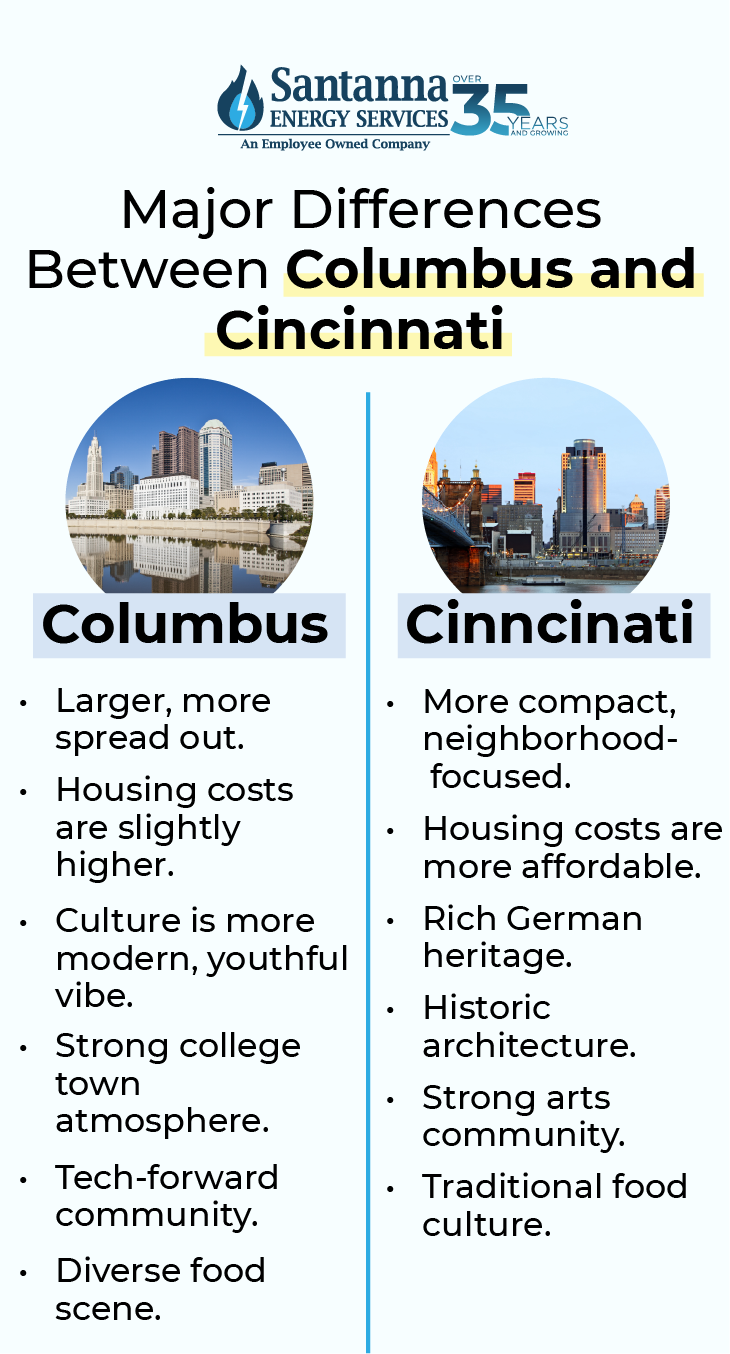Cincinnati vs Columbus: Where Should You Live?
by Jenna Mendez
26.9 min read

Ohio is home to two of the Midwest's most dynamic cities: Cincinnati and Columbus. While both cities are packed with opportunities, culture, and charm, they offer distinctly different lifestyles that cater to diverse needs and preferences.
Cincinnati vs Columbus: which should you choose? If you're considering moving to one of these iconic cities but aren't sure which one is the best fit for you, don't worry—we're here to break it down. From housing and the cost of living to cultural vibes and job markets, this guide will help you navigate the key differences and decide where you'll feel most at home. Let's dive in!
Columbus and Cincinnati: What Makes Them Unique?
Often called the "Queen City," Cincinnati is renowned for its historic Over-the-Rhine (OTR) district, vibrant arts scene, and rich German heritage. Here's what makes Cincinnati stand out:
Rich History: Cincinnati's Over-the-Rhine district is a treasure trove of 19th-century German-inspired architecture, making it one of the largest historic neighborhoods in the U.S. The city embraces its heritage through events like Oktoberfest, one of the largest celebrations of its kind outside of Germany.
Arts and Entertainment: Cincinnati is home to world-class museums, theaters, and symphonies, including the Cincinnati Art Museum and the Aronoff Center for the Arts. The vibrant arts scene ensures there's always a gallery to explore or a show to enjoy.
Sports Passion: Sports lovers will thrive in Cincinnati, with professional teams like the Bengals (NFL), Reds (MLB), and FC Cincinnati (MLS). The city also hosts major tennis events, making it a hub for athletic excitement.
Affordable Living: Cincinnati offers a lower cost of living, with budget-friendly housing, dining, and entertainment options. Whether you're a young professional, family, or retiree, the city's affordability adds to its charm.
As Ohio's capital, Columbus combines modern innovation with a youthful and vibrant atmosphere. Here's what makes Columbus unique:
Thriving Tech Hub: Columbus is a leader in technology and innovation, attracting companies like Amazon, Google, and Facebook. The Smart Columbus initiative further highlights its forward-thinking approach, making it ideal for tech professionals.
The Ohio State University: The presence of The Ohio State University energizes the city, contributing to its research, sports culture, and youthful vibe. OSU is a cultural and economic powerhouse that plays a significant role in Columbus's identity.
Diverse Food and Culture: Columbus offers an eclectic food scene featuring global cuisines, trendy restaurants, and lively food festivals. The Short North Arts District is a hub of creativity with galleries, nightlife, and boutiques.
Green Living: Columbus is a paradise for outdoor enthusiasts. The Scioto Mile Park system and bike-friendly infrastructure promote a healthier, greener lifestyle, connecting residents with nature even in the heart of the city.
Interested in learning more about these cities? Continue reading for the full scoop!
Cincinnati vs Columbus: The Basics
Deciding between Cincinnati and Columbus, two of Ohio's most dynamic cities, can be tough. Each offers unique opportunities, cultural experiences, and lifestyle benefits. Whether you're drawn to Cincinnati's historic charm and vibrant arts scene or Columbus's youthful energy and growing tech hub, we will help you explore which city best fits your needs. Let's start with the basics, like weather, population, and size, to help you decide.
Columbus vs. Cincinnati in Size and Population
When comparing the size and population, Columbus is larger than Cincinnati. According to the latest U.S. Census estimates (May 2024), Columbus has a population of 915,427 and spans 220.7 square miles. This makes it the largest city in Ohio, boasting a more urbanized and spread-out layout.
On the other hand, Cincinnati has a population of 311,595 within 77.9 square miles. Cincinnati's smaller size contributes to a cozy, neighborhood-centric feel, while Columbus's scale offers a sense of metropolitan vibrancy. Your choice between the two may depend on whether you prefer the energy of a bustling capital or the charm of a tightly-knit urban community.
Weather and Climate in Cincinnati vs. Columbus
Both Cincinnati and Columbus enjoy the beauty and variety of four distinct seasons, each offering unique experiences throughout the year. Summers in both cities are warm and humid, perfect for outdoor activities, while winters bring cold temperatures and moderate snowfall. Cincinnati sometimes experiences additional chill and lake-effect snow due to its proximity to the Ohio River.
Spring and fall are standout seasons in both cities. They are characterized by mild temperatures and vibrant scenery, making them ideal times for festivals, parks, and outdoor adventures. However, both cities are susceptible to severe weather, including thunderstorms and occasional tornadoes, so residents should stay prepared during peak storm seasons.
Distance Between Cincinnati and Columbus
The distance between Cincinnati and Columbus is approximately 102 miles / 164 km, making travel between the two cities straightforward and manageable. The journey typically takes around 1 hour and 54 minutes by car, depending on traffic conditions. While direct public transit options are limited, budget-friendly services like Greyhound and Megabus provide convenient alternatives for non-drivers.
Whether you're heading to Cincinnati for its rich history or to Columbus for its modern energy, the journey itself can add to the experience.

Columbus vs. Cincinnati: Cost of Living & Housing
In 2025, Cincinnati, Ohio's cost of living is 2% higher than that in Columbus, Ohio. While housing is more affordable in Cincinnati, transportation and lifestyle costs tend to be higher. Let's dive deeper into the cost of living and housing in Columbus vs. Cincinnati.
Housing
When it comes to housing, both cities offer something unique depending on your budget and lifestyle preferences. Cincinnati shines with its lower median home prices and rental rates, making it an excellent choice for first-time buyers or those looking for affordable housing.
On the other hand, Columbus caters to a diverse range of lifestyles with a variety of modern apartments, urban lofts, and spacious suburban homes. Although housing costs are slightly higher than in Cincinnati, the variety ensures that you can find a place that fits your needs, whether you're a young professional, a growing family, or someone seeking a vibrant downtown lifestyle in districts like the Short North.
Utilities and Transportation
Residents in both cities enjoy relatively affordable utility costs, with Cincinnati being slightly cheaper at an average $398.19 per month, compared to Columbus at $400.56.
Columbus offers a more extensive public transit system, including the Central Ohio Transit Authority (COTA) buses, which provide accessible and affordable commuting options. This can be a huge advantage if you prefer not to rely on a car for daily travel.
While more car-dependent, Cincinnati has made strides with its "Complete Streets" initiative, aiming to create safer, more sustainable roads. For those who drive, both cities experience similar gas prices and traffic patterns, so your choice may come down to whether you prioritize public transit or personal vehicle use.
Food and Groceries
Grocery costs are almost identical in Cincinnati and Columbus, so your choice of city won't drastically impact your weekly grocery budget. Where the difference lies is in dining out. Cincinnati is known for its affordable yet dynamic culinary scene, featuring iconic dishes like Cincinnati chili and a range of budget-friendly restaurants and eateries. If you love exploring local flavors without breaking the bank, Cincinnati might be the better fit.
Meanwhile, Columbus offers a diverse food landscape, including innovative restaurants and food trucks serving cuisines from around the globe. The Short North Arts District and German Village are culinary hotspots, perfect for foodies looking for variety and elevated dining experiences. No matter which city you choose, your taste buds will be well taken care of.

Entertainment
Both cities excel in entertainment options but in different ways. C Columbus boasts a vibrant cultural and arts scene, home to live music venues, art galleries, and festivals that reflect its modern and youthful energy. While these activities can come with a slightly higher price tag, they offer unparalleled experiences for those who thrive on culture and creativity.
Cincinnati, by contrast, offers a mix of affordable, family-friendly attractions and historical landmarks. From the Cincinnati Zoo to the National Underground Railroad Freedom Center, the city provides enriching experiences that won't strain your wallet. Its thriving arts community, combined with a love for history, ensures there's something for everyone to enjoy.
Cost of Living and Housing: Cincinnati vs. Columbus
| Cincinnati, OH | Columbus, OH | |
|---|---|---|
| Housing for Sale | $258,250 | $275,350 |
| Apartment for Rent | $1,391 | $1,606 |
| Utilities (Energy & Phone Bill) | $398.19 | $400.56 |
| Groceries | $148.46 | $148.29 |
| Transportation (Gas Per Gallon) | $3.21 | $3.21 |
| Healthcare | $498.72 | $446.12 |
| Lifestyle | $243.84 | $236.19 |
Cincinnati vs. Columbus: Job Markets and Top Industries
Both Cincinnati and Columbus offer thriving job markets with opportunities across diverse industries, making either city an excellent choice for career growth. As of November 2024, Cincinnati's unemployment rate is 3.9%, reflecting a significant decline of over 35% since January 2021. Columbus edges slightly ahead with a 3.7% unemployment rate as of November 2024, keeping both cities relatively even in job availability.
In Cincinnati, you'll find top industries and careers in:
Advanced Manufacturing: Cincinnati is home to one of the nation's busiest inland ports and supports a robust manufacturing sector. GE Aerospace is a standout employer, attracting top talent in production and engineering.
Life Sciences: The region offers a cost-competitive environment and a deep pool of BioHealth workers, with 25% more relative to the U.S. average. Companies include CTI, Enable Injections, Cordata, and more.
Business and Professional Services: Cincinnati has a large pipeline of workers, fast-growing businesses, and one of the highest concentrations of consumer insights talent in the nation. Companies to work for include Kroger, P&G, GE, and more.
Technology: Cincinnati is known for regional innovation and an extremely cost-effective operating environment.
In Columbus, you'll find great-paying careers in many diverse industries, including:
Finance and Fintech: Companies like JPMorgan Chase and Huntington offer well-paying jobs in banking and financial technology.
Retail: Columbus is home to major retail headquarters, including Abercrombie & Fitch and Bath & Body Works, creating abundant opportunities in fashion and supply chain roles.
Life Sciences: Cardinal Health anchors this sector, driving advancements in pharmaceuticals and healthcare solutions.
Insurance and Insurtech: Nationwide stands out as a key employer, contributing significantly to Columbus's reputation as a leader in the insurance industry.
Automotive and Mobility: Honda has a substantial presence in the region, supporting jobs in manufacturing and innovation in mobility solutions.
Logistics and Distribution: Columbus's central location makes it a hub for companies like Amazon and DHL, which drives growth in logistics and distribution.
Columbus vs. Cincinnati: Safety, Crime Rates, and Eco-Friendliness
Safety and eco-friendliness play a critical role in determining the quality of life in any city, and both Columbus and Cincinnati are taking proactive steps to enhance these aspects. While Cincinnati has higher crime rates, both cities are implementing innovative programs and policies to improve public safety and sustainability.
Violent crime rates in Cincinnati are 38% higher than in Columbus, and property crime is 23% more prevalent. To combat this, the city has strengthened its police presence downtown, introduced Downtown Ambassadors who patrol the streets, and implemented the "Safe and Clean" Program to reduce crime, clean streets, and remove graffiti.
While Columbus is safer statistically, it is also making its city safer through initiatives like the TAPS Academy, which builds trust between at-risk youth and police officers, and Columbus Violence Reduction (CVR), which focuses on high-risk individuals to prevent violent crimes.
Both cities are making strides in promoting eco-friendly practices and improving transportation infrastructure, though they approach these goals differently. Cincinnati has adopted its Complete Streets policy, which focuses on creating safer and more sustainable roadways.
These include dedicated lanes for cyclists to ensure their safety and encourage eco-friendly transportation, improved and expanded sidewalks to make walking safer and more accessible, plastic curb extensions to help slow down traffic and make pedestrians more visible, and enhanced crosswalks to protect pedestrians and reduce accidents.
On the other hand, Columbus received a $40 million grant from the U.S. Department of Transportation to test innovative ways to improve transportation. The city's projects include real-time safety alerts for drivers, better access to bus stops, and a self-driving shuttle delivering food to residents.
Columbus has also focused on improving its residents' quality of life by building bike and fitness trails that connect suburbs, river trails, and a rejuvenated downtown park system.
Food and Culture Cincinnati vs. Columbus
Both Cincinnati and Columbus boast rich food scenes and vibrant cultural experiences, but each city brings its own flavor and personality to the table.
Cincinnati's culinary identity is deeply tied to its German roots, exemplified by iconic dishes like goetta, a breakfast sausage that blends meat and oats. It's also famous for Cincinnati-style chili served over spaghetti or hot dogs. The city's food culture thrives in neighborhoods like Over-the-Rhine, where historic charm meets trendy eateries. It's also home to celebrated food festivals like Taste of Cincinnati, one of the longest-running culinary festivals in the U.S.
Columbus is a hub for innovative and diverse cuisine, from farm-to-table dining to international flavors. The city is home to the North Market, where you can find everything from Vietnamese pho to artisanal baked goods. Columbus is also a test market for many restaurant chains, making it a hotspot for new and experimental dining experiences. It boasts a diverse food scene with numerous restaurants, breweries, and food trucks, reflecting its multicultural population.
Cincinnati vs Columbus: Shopping and Nightlife
Both Cincinnati and Columbus offer a variety of shopping and nightlife options, catering to different tastes and preferences. Whether you're drawn to historic charm or modern trends, each city has something special to offer. Here's how they compare:
Shopping in Cincinatti
Cincinnati blends its rich history with modern retail options, making it a shopping destination for every kind of buyer. Findlay Market, located in the Over-the-Rhine district, is a must-visit for fresh produce, artisan goods, and unique finds.
Kenwood Towne Centre features luxury brands and department stores, catering to those seeking a premier retail experience. Boutique and vintage shopping enthusiasts will enjoy exploring Over-the-Rhine and Hyde Park, where trendy shops, local artisans, and specialty stores create a vibrant retail scene.
When it comes to nightlife, Cincinnati's energy shines in districts like Over-the-Rhine and The Banks. Over-the-Rhine offers an artsy vibe with craft cocktail bars, wine lounges, and live music venues like MOTR Pub and Arnold's Bar and Grill, the latter being one of the city's oldest taverns.
The Banks area, located along the Ohio River, provides a lively mix of sports bars, rooftop lounges, and scenic riverfront views, perfect for those who enjoy a dynamic social atmosphere. Cincinnati's shopping and nightlife exude a unique combination of historic charm and modern excitement, offering something for everyone.
Shopping in Columbus
Columbus is a trendsetter in shopping, boasting innovative retail destinations like Easton Town Center, a sprawling indoor-outdoor complex with high-end brands, restaurants, and entertainment options. For a more eclectic shopping experience, the Short North Arts District offers unique boutiques, art galleries, and locally crafted goods. Budget-conscious shoppers will appreciate the Tanger Outlets Columbus, which features a wide range of designer and brand-name stores at discounted prices.
The nightlife in Columbus is as diverse as its residents. The city is known for its thriving LGBTQ+ scene, with hotspots like Axis Nightclub and drag shows at Union Café drawing vibrant crowds. Craft beer enthusiasts can enjoy local brews at popular spots like BrewDog and Seventh Son Brewing, while sports bars come alive on game days, especially during Ohio State football season. Columbus's youthful and inclusive energy shines through in its nightlife, offering an inviting space for all.
The Sports Scene in Cincinnati and Columbus
Both Cincinnati and Columbus boast thriving sports cultures, offering fans an exciting array of teams and events to rally behind.
Cincinnati is home to professional teams like the Cincinnati Bengals (NFL) and the Cincinnati Reds (MLB). Beyond professional sports, Cincinnati also has a strong college sports presence, with local teams competing in a variety of events. The city regularly hosts major sporting events, keeping its sports calendar packed year-round.
Columbus is the home of the Ohio State Buckeyes, which have a strong following in college football and basketball. The city also hosts the Columbus Blue Jackets (NHL) and Columbus Crew SC (MLS), offering a diverse sports environment for enthusiasts.

Education: Cincinnati vs Columbus
Both Cincinnati and Columbus are home to well-regarded educational institutions, offering diverse opportunities for students and professionals alike. Here's a comparison of their education landscapes:
Cincinnati
Cincinnati is home to the University of Cincinnati (UC), a top-ranked public research university celebrated for its innovative co-op programs. These programs allow students to gain hands-on professional experience while pursuing degrees, with particularly strong programs in architecture, engineering, and health sciences. The city also boasts Xavier University, a prestigious Jesuit institution known for its close-knit campus and focus on liberal arts and business education, providing a well-rounded academic environment.
For K-12 education, the Cincinnati Public Schools (CPS) system has been making strides in academic performance, offering specialized programs to support student growth. However, according to Niche, Cincinnati public schools currently average a "C+," reflecting room for continued improvement.
Columbus
Columbus stands out as the home of The Ohio State University (OSU), one of the largest and most prestigious public universities in the nation. OSU offers a wide array of highly regarded programs, including business, engineering, and healthcare, alongside a vibrant campus culture. Smaller institutions like Capital University and Otterbein University provide personalized liberal arts and professional education, ensuring diverse higher education options for residents.
For younger students, the Columbus City Schools (CCS) district, the largest in Ohio, offers various programs to cater to different interests and needs. These include magnet schools, language immersion programs, and STEM-focused academies. According to Niche, Cincinnati public schools average a "C+," signaling similar challenges in academic outcomes.
Best Places to Live in Cincinnati, Ohio
If you're wondering if Cincinnati, Ohio, is a good place to live, the answer depends on your preferences. Check out these top 5 best places to live in Cincinnati, Ohio:
Blue Ash
Known for its excellent schools and family-oriented atmosphere, Blue Ash is a popular suburb that offers a blend of suburban tranquility and city convenience. It's home to beautiful parks, including Summit Park, which features walking trails, live events, and a vibrant community feel. The area also boasts a strong economy and thriving local businesses.
Mariemont
Step into this picturesque village, often described as a storybook town. Mariemont is known for its Tudor-style architecture, charming streets, and walkability. It's a perfect place for families, with its highly rated schools, local theater, and a strong sense of community. The village square is a hub of activity, featuring boutique shops, cafes, and seasonal events, making Mariemont one of the best places to live in Cincinnati.
Mason
Frequently ranked as one of the best places to live in Ohio, Mason is ideal for families and professionals alike. It's known for its outstanding schools, extensive park system, and entertainment options like Kings Island amusement park. Mason offers a mix of affordable housing and upscale living, with plenty of amenities to enjoy.
Madeira
With a small-town feel and big-city benefits, Madeira is a close-knit community that prides itself on safety, excellent schools, and a walkable downtown area. Residents enjoy local shops, dining options, and an active community life that includes seasonal festivals and farmer's markets, making it one of the best places to live in Cincinnati.
Montgomery
If you're looking for a suburban area with a historic charm, Montgomery is the perfect choice. It features top-rated schools, well-maintained neighborhoods, and a quaint downtown filled with boutique stores and fine dining options. Montgomery is known for its welcoming community and serene living environment.

Best Places to Live in Columbus, Ohio
If you're looking for vibrant city living, family-friendly suburbs, or charming historic areas, this bustling capital has something for everyone. Here are the best places to live in Columbus, Ohio:
Bexley
Bexley combines historic charm with modern amenities, making it a top choice for families and professionals. Located just minutes from downtown Columbus, it's known for its tree-lined streets, beautiful homes, and excellent schools. The city also boasts a thriving arts scene and a strong sense of community.
Powell
This upscale suburb is known for its family-friendly environment and highly rated schools. Powell offers spacious homes, scenic parks, and a charming downtown filled with local boutiques and restaurants, making it one of the best places to live in Columbus. Residents enjoy a high quality of life with access to many recreational opportunities.
Upper Arlington
Located near The Ohio State University, Upper Arlington is a prestigious neighborhood with a focus on education, safety, and community. It's known for its beautiful homes, lush parks, and strong school district. The area also features a variety of local events, including farmers' markets and art festivals.
Dublin
Dublin blends a small-town feel with modern conveniences. It has excellent schools, a vibrant downtown area, and cultural events like the Dublin Irish Festival. Residents appreciate the abundance of parks, walking trails, and golf courses. The community fosters a sense of togetherness with its strong focus on family and quality of life, making it one of the best places to live in Columbus, Ohio.
Top Things to Do in Cincinnati Ohio
No matter how you look at it, Cincinnati, Ohio, is bursting with activities and experiences! From exploring its famous landmarks and immersing yourself in the vibrant arts scene to enjoying the natural beauty of the outdoors, there's always something exciting to discover. Take a look at our list of must-see attractions in Cincinnati, Ohio:
1919: The Year That Changed Baseball Tour
Dive into one of baseball's most pivotal moments with the 1919: The Year That Changed Baseball Tour. This immersive experience takes visitors back to the infamous "Black Sox Scandal," where the Cincinnati Reds secured victory in the 1919 World Series amidst one of sports history's biggest controversies. Perfect for baseball enthusiasts and history buffs alike, this tour provides a fascinating glimpse into how this moment shaped the sport forever.
American Sign Museum
Step into a world of nostalgia at the American Sign Museum, a one-of-a-kind destination that celebrates the evolution of American signage. From intricately hand-painted signs of the 1800s to dazzling neon creations of the mid-20th century, this museum offers a visual journey through time. It's a perfect spot for anyone who loves history, art, or design, and it's guaranteed to inspire and delight.
The Ultimate Queen City Haunted Tour
Discover Cincinnati's haunted past with spine-chilling ghost stories and historical mysteries in Over-the-Rhine. This tour uncovers ghostly tales, mysterious happenings, and eerie legends that bring the city's haunted past to life. As one of Cincinnati's top-rated haunted tours, it's a thrilling adventure for those who love history with a side of suspense.
Music Hall
A masterpiece of culture and architecture, Music Hall is one of Cincinnati's crown jewels. Home to the Cincinnati Symphony, Opera, and Ballet, this historic venue offers world-class performances that captivate audiences year-round. Even if you're not attending a show, guided tours allow you to explore its stunning design and learn about its rich history.
Ready to discover more incredible attractions in Cincinnati? From hidden historical gems to vibrant cultural hotspots, there's something for everyone. Explore all the amazing things this city has to offer here.
Top Things to Do in Columbus Ohio
Columbus is full of incredible attractions for everyone to enjoy. Whether you're exploring nature, diving into history, or indulging in art and culture, there's so much more waiting for you. Check out our list of must-see spots and hidden gems in Columbus, Ohio.
Franklin Park Conservatory and Botanical Gardens
Escape the hustle and bustle of the city at Franklin Park Conservatory and Botanical Gardens. Explore vibrant indoor and outdoor displays featuring exotic plants from around the globe. On the first Sunday of every month, free community days provide access to the stunning garden collections and seasonal exhibits.
Columbus Park of Roses
Nestled in Whetstone Park, the Columbus Park of Roses spans 13 acres and showcases over 11,000 roses in more than 350 varieties. From the formal rose garden's symmetry to the historic blooms of the Heritage Garden, each area presents a unique floral experience. Visitors can also enjoy the aromatic Herb Garden and pollinator-friendly Backyard Garden. It's the perfect spot for photographers, nature enthusiasts, and anyone seeking a peaceful retreat.
The Ohio Craft Museum
Immerse yourself in Ohio's craft heritage at this free museum featuring ceramics, glass, wood, metal, and fiber art. The Ohio Craft Museum is a must-visit for creatives and art lovers, with rotating exhibitions, artist lectures, and interactive workshops. Discover the intricate artistry and evolving traditions that make Ohio a hub for craftsmanship.
Scioto Audubon Metro Park
Once an industrial area, this park has been transformed into a nature lover's paradise. Scioto Audubon Metro Park offers dog parks, rock-climbing walls, and scenic walking paths along the Scioto River. Whether you're looking for outdoor adventure or a peaceful spot to relax, this park is a top choice for free activities in Columbus. The Scioto Audubon Metro Park is located at 400 W Whittier St, Columbus, OH 43215.
Looking for even more things to see and do in Columbus? Dive into the city's diverse attractions and discover experiences for every interest here.
Columbus Zoo vs Cincinnati Zoo: Which is Better?
Both the Columbus Zoo and the Cincinnati Zoo are highly regarded destinations that offer unique experiences for animal lovers and families. Whether you're planning a day trip or looking to explore world-class wildlife exhibits, here's a breakdown to help you decide if a visit is worth your time.

The Columbus Zoo is renowned for its expansive grounds. It features over 10,000 animals across 600 species, ranging from Cheetahs to the mighty Wolverine, so you're bound to find a favorite. The Columbus Zoo has seven areas to explore and learn about animals.
For example, The Heart of Africa exhibit allows guests to experience a safari-like atmosphere, and the Manatee Coast houses rare manatees, making the zoo a must-see for those interested in conservation.
Cincinnati Zoo & Botanical Garden is the second-oldest zoo in the United States. It is famous for its historic charm and beloved animals like Fiona the hippo. Home to 400 animal species and 3,000 plant species, it is globally recognized for its leadership in endangered species reproduction, innovative education programs, and sustainable green practices.
It offers a more intimate experience than Columbus, with beautifully landscaped botanical gardens throughout the park. The zoo became a conservation and sustainability champion, earning the title of "Greenest Zoo in America."
When it comes to choosing which one to visit, you really can't go wrong with either! It's truly up to you. No matter which one you choose, you're in for an educational treat.
The Ultimate List of Pros & Cons of Living in Columbus and Cincinnati
If you're still deciding between Columbus vs. Cincinnati, check out our list of the ultimate pros and cons.
Cincinnati: Pros
- Vibrant Nightlife and Entertainment: Cincinnati's Over-the-Rhine (OTR) district is a cultural gem, buzzing with trendy bars, craft breweries, live music venues, and top-tier entertainment options. It's a haven for those seeking an exciting social scene paired with unique historic charm.
- Affordable Living: Cincinnati stands out for its affordability, with housing costs requiring only 19% of median earnings—one of the lowest in large U.S. cities. Combined with economical rent prices, it's an attractive option for budget-conscious individuals and families.
- Family-Friendly Education: Cincinnati public schools are generally rated higher than those in Columbus, making the city a strong contender for families seeking better educational opportunities.
- Cultural Accessibility: Easy access to landmarks, museums, and events enhances the city's walkable urban appeal. It's a city where history and modern living intertwine seamlessly.
Cincinnati: Cons
- Transportation Challenges: Cincinnati lacks a robust public transit system, forcing most residents to rely on cars for commuting. It also has America's largest abandoned subway system, a symbol of missed transit development.
- Public Transportation: The underdeveloped infrastructure means fewer convenient transit options, which can be a barrier for those without access to a personal vehicle.
- Urban Walkability: While areas like OTR are pedestrian-friendly, many suburban neighborhoods lack walkable amenities, making car dependency a necessity in much of the city.
Columbus: Pros
- Thriving Economy: Columbus boasts a dynamic and diverse economy, offering strong job prospects in industries like technology, medical research, education, and aviation. Major employers like Amazon, The Ohio State University, and Honda contribute to a flourishing job market.
- Sports Culture: The Ohio State University creates a vibrant sports atmosphere, especially for football enthusiasts. Game days transform the city into a hub of excitement, fostering a deep sense of community.
- Cultural Scene: Columbus is a creative hub, with the Short North Arts District, live music venues, and annual festivals, making it a magnet for young professionals, artists, and culture lovers.
- Diverse Housing Options: Columbus offers a range of housing choices, from modern downtown apartments to family-friendly suburban homes, catering to varying budgets and lifestyles.
Columbus: Cons
- Public Schools: While improving, public schools in Columbus are generally rated lower than those in Cincinnati, which may influence families prioritizing education for their children.
- Car Dependency: Although Columbus has a slightly better transit system than Cincinnati, many areas remain heavily car-dependent, with public transportation not yet meeting the standards of larger cities.
- Limited Urban Walkability: Columbus is spread out, and while districts like Short North are walkable, much of the city lacks the pedestrian-friendly infrastructure found in other metropolitan areas.
Overall, is Cincinnati a Good Place to Live?
Cincinnati offers a rich blend of culture, affordability, and family-friendly amenities. Overall, Cincinnati is a great place to live! It's an excellent choice for those seeking a balance between urban charm and budget-conscious living. Families benefit from quality public schools and access to cultural landmarks.
Overall, is Columbus a Good Place to Live?
Columbus stands out as a city of opportunities, offering a thriving economy, a vibrant sports culture, and a dynamic arts scene. Overall, Columbus is a great place to live as well! Its diverse job market and affordable housing make it attractive to young professionals and those starting new careers.
Cincinnati vs Columbus: Where Should You Live?
The choice is truly up to you! But here's something to help:
Consider moving to Cincinnati, Ohio if…
- You're looking for affordable housing.
- You prioritize family-friendly living with better-rated public schools.
- You want easy access to cultural landmarks, trendy neighborhoods, and a lively entertainment scene.
- You're drawn to a more historic and architecturally rich urban environment.
Choose Cincinnati if you value historic charm, affordability, and a strong sense of community. It's ideal for families, young professionals, and those seeking a quieter yet culturally rich environment.
Consider moving to Columbus, Ohio if…
- You're seeking diverse career opportunities in industries like tech, healthcare, education, or aviation.
- You enjoy a vibrant sports culture, especially college football, and don't mind a college town.
- You value a dynamic arts and music scene with plenty of cultural activities.
- You prefer slightly better transit options and more suburban-style living.
Choose Columbus if you're drawn to a vibrant, modern city with abundant career opportunities, a lively food and arts scene, and better transportation infrastructure. It's perfect for tech workers, urbanites, and students.
Both cities have unique strengths, so the best choice ultimately depends on your individual lifestyle and goals.
Ready to Make the Move? Don't Forget Your Utilities!
Whether you're planning a move to Cincinnati or Columbus, setting up your utilities should be at the top of your to-do list.
We proudly serve both cities, offering predictable and reliable energy solutions tailored to your needs. With competitive electricity and natural gas plans available to Columbus and Cincinnati customers, switching to Santanna Energy Services can make your move smoother. Start your next chapter on the right foot by choosing an energy provider you can trust —explore our plans available in Cincinnati or Columbus and find the best fit for your home.
Jenna Mendez is a Midwest native with lifelong roots in Illinois and time spent in Ohio during college, giving her a deep understanding of the Midwest region’s people, climate, and energy needs. She brings firsthand experience and local insight to topics that matter to Midwest homeowners, especially energy efficiency, sustainability, and home living. Jenna specializes in writing about eco-friendly living, all things Midwest, renewable energy, and practical ways to reduce energy costs. Jenna brings a trusted, and local hometown voice to every article she writes, helping readers live well, and sustainably, right where they are.







